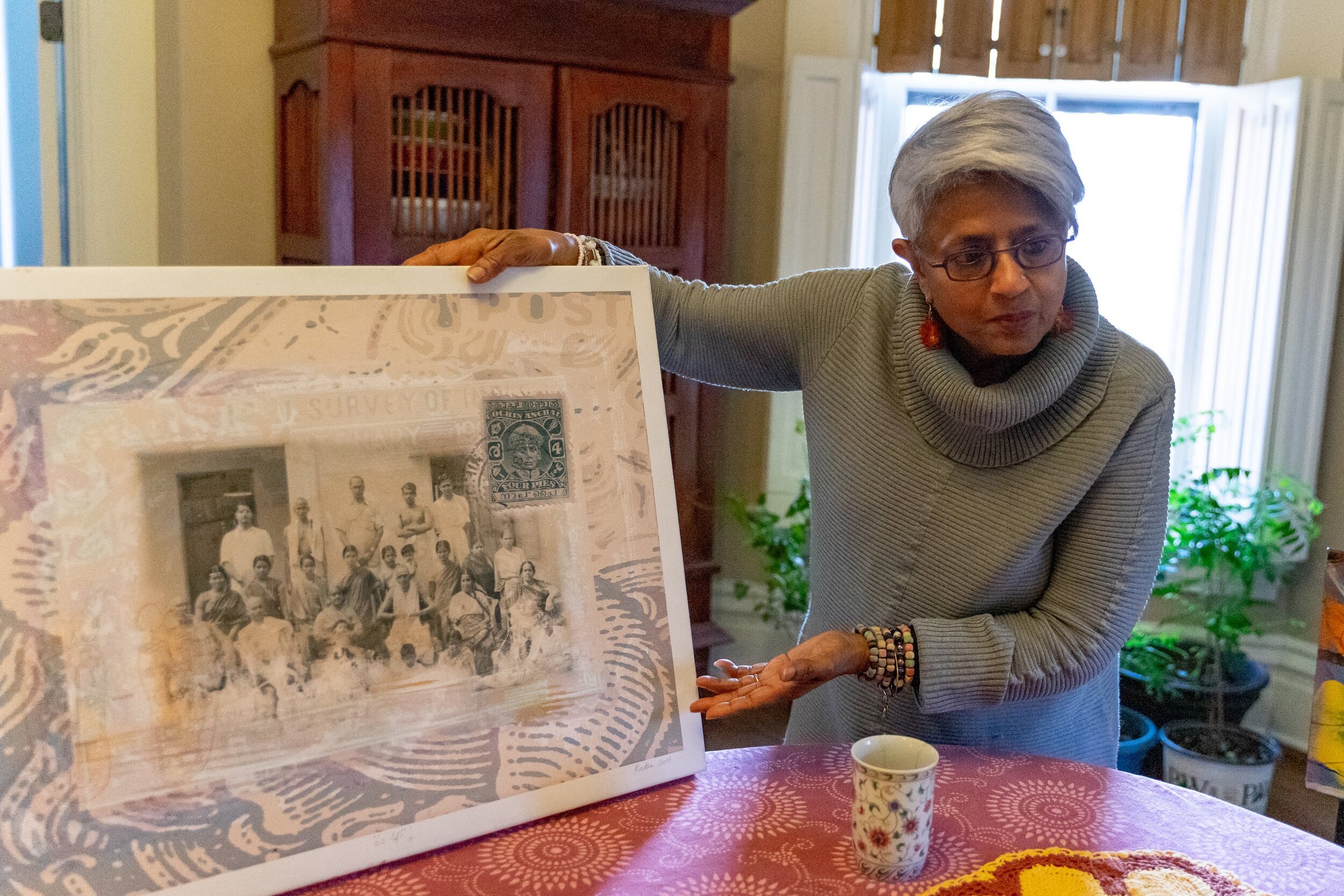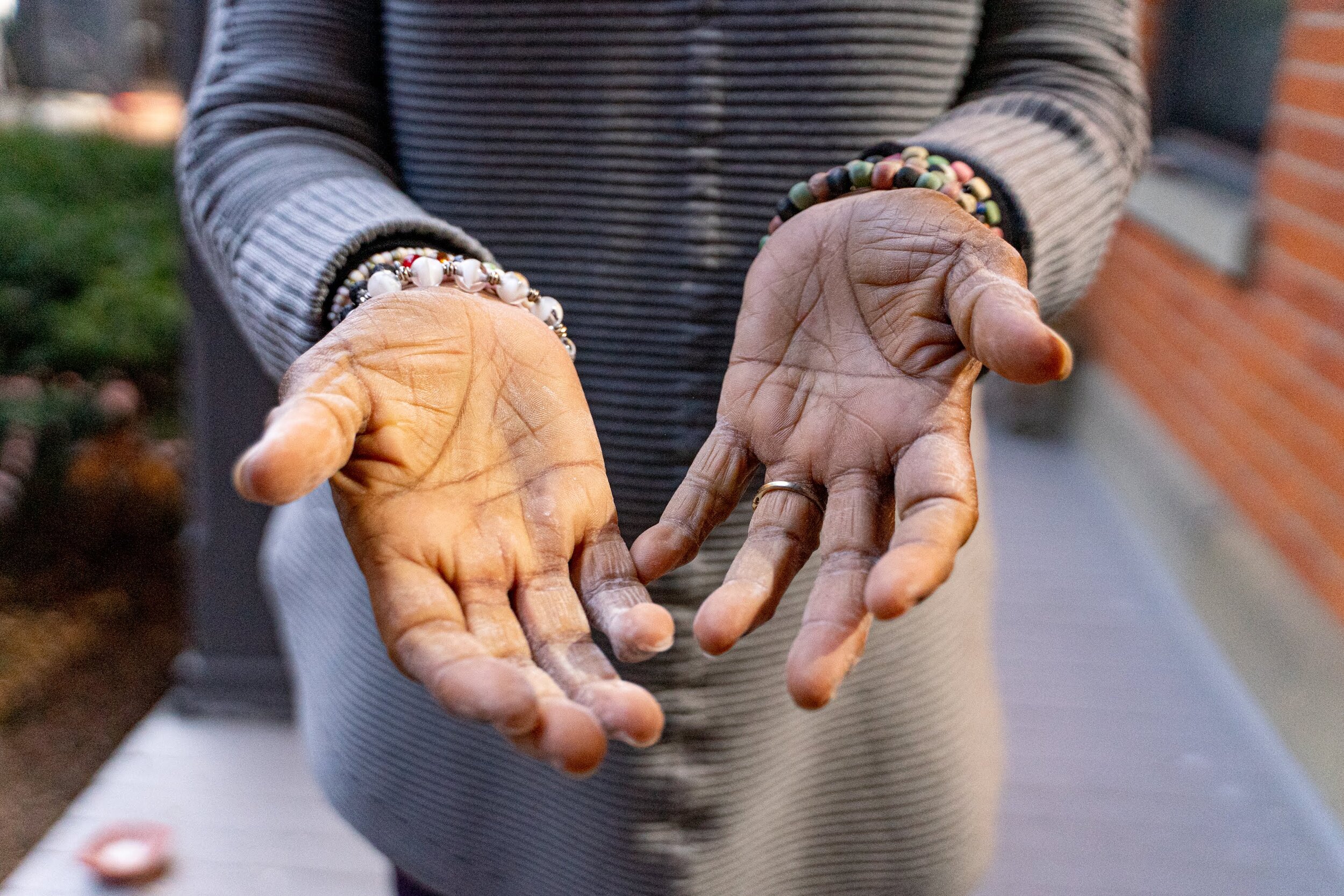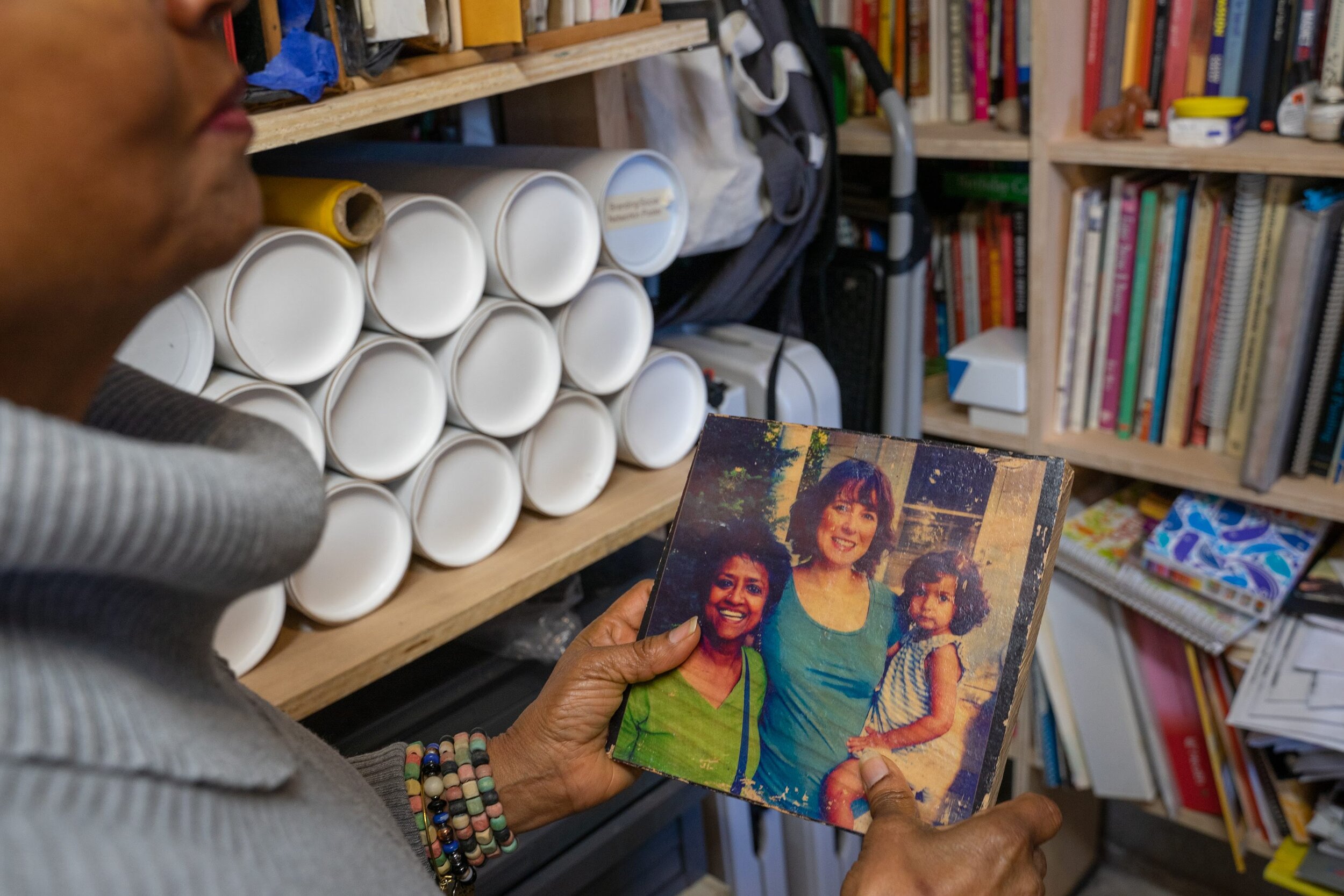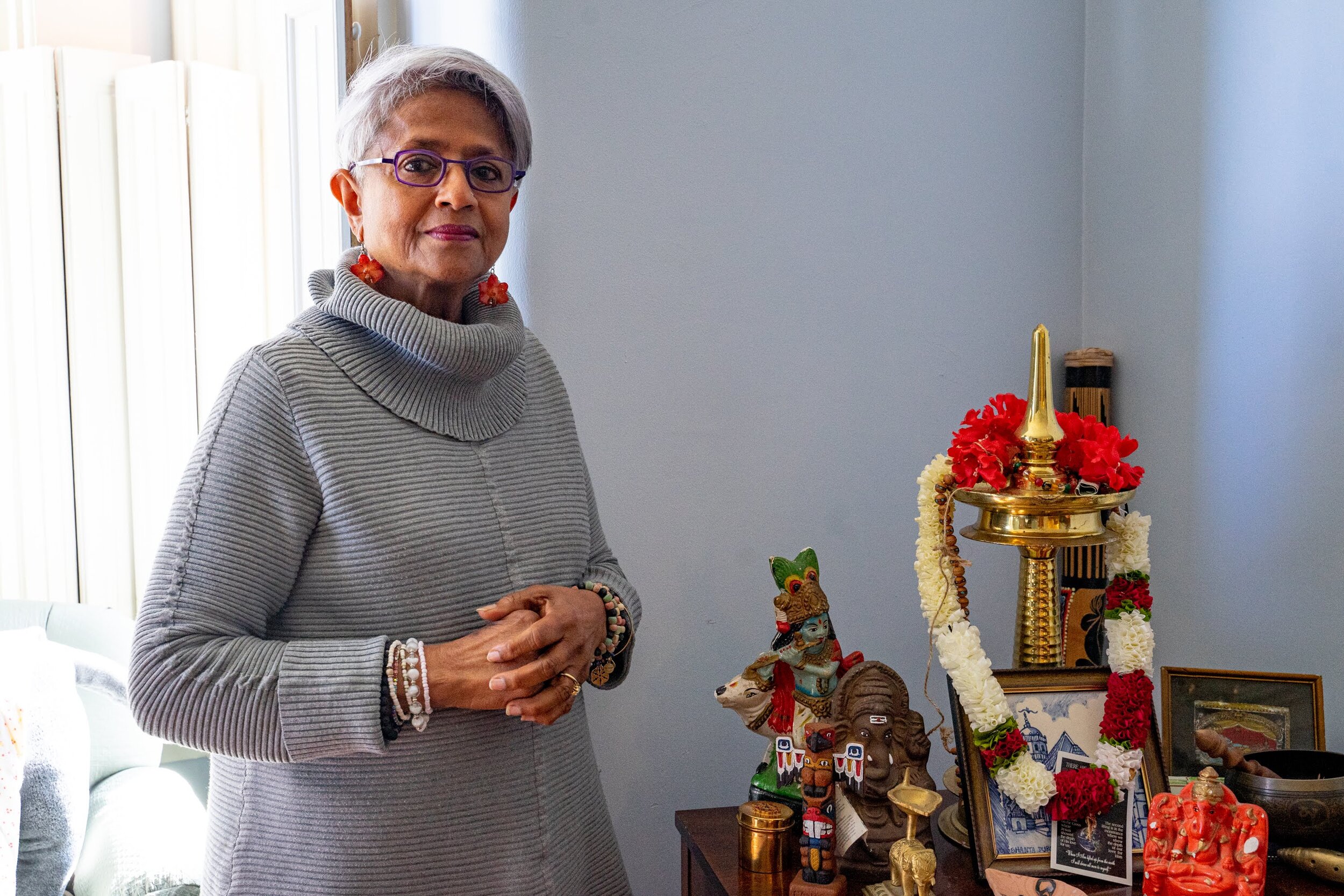Home Away from Home: Radha Lakshmi
In Chennai, Southern India, women rise before dawn. It is their quiet time with the universe, free from the hectic schedule about to begin with the rising of the sun. They clean the front yards of their homes and draw geometrical rice powdered patterns on the ground leading to the entrances of their home. It's a traditional Indian ritual meant to create a sacred space as one enters the home. The beauty of the designs is supposed to capture any bad energy that might enter the home. For over 2,000 years mothers have passed this tradition and knowledge to their daughters. It is different in other parts of India, and here in the West, it's commonly associated with Buddhism and the designs we know as mandalas.
For Radha Lakshmi, this traditional ritual runs deep. As a young girl growing up in India, rituals like this molded who she would become. She woke up at the crack of dawn, helped the older women mix the rice powder into a paste, and listen to them gossip about their marriages, the milkman, and everything else in between. As she grew into a young woman, she found a connection with this ritual that would inform the woman we meet today. She would go on to beat breast cancer, survive an abusive marriage, fall in love, and become a community artist Cincinnati has fallen in love with. She has taught us how to beautify our yoga mats, find healing in the beauty of nature, and explore our spirituality through ritual and art forms.
For the three hours we visited with Radha, Emily and I were transported into her enchanting world. We drank refreshing herbal tea in a home filled Indian artifacts on walls, tables, couches - even the teacups felt unique. The most seemingly innocent item in the house has its own story, and Radha is a beautiful storyteller who knows how to invite you in her world in which, for those moments, the enchantment is quite real.
Interview by Clara Matonhodze Strode. Photography by Emily Palm.
Radha, can you start by telling us how you define yourself?
Yes, sure. I was born in Chenai, India, in 1951. I consider myself a community artist. I'm a mother, a daughter, a sister, and a grandmother, and a very passionate individual. I love life. Over the years, I have travelled and collaborated with tribal artists in India, Australia, and the First Nations people in Canada. It has empowered me in many ways. My art has evolved into this magical, spiritual connotation that is still being kept alive by myself and other indigenous from around the world. I feel like my life has come full circle.
How so?
Well, my life has come full circle, just like the mandala. The mandala, "circle" in Sanskrit, represents wholeness, an integrated view of the world and the universe. Making a mandala is described as the process of mapping one's inner world. My meditation, art, and teaching how to create sacred spaces has made me complete. I find myself slipping into a trance-like state and lose myself to the cosmic story that is unfolding in front of my very eyes. This whole process is very ritualized. Many people will say that no healing can happen unless there's a ritual involved, some kind of routine. And in my case, it's the ritual of teaching to create sacred spaces through meditation or a mandala. I hope and pray for peace for everyone.
If I may, what do you seek healing from?
A lot of things, but I don't want to say anything bad about my family because I'm sure they did their best. What I will tell you is that I was in a very abusive marriage. During the 1970s, my generation of young women was in a culture shock as we were the 'new' young Indian women intuitively challenging all the old patriarchal traditions. I began studying visual art in the early 1970s in the Government College of Arts, Chennai, in Tamil Nadu, where I was tutored to paint with a western approach to fine art, emphasizing personal creativity and originality. My marriage was abusive; I had to walk away. I walked out of the union with two beautiful young children. I was humiliated. I just wanted to move on and raise my kids.
What happened after you left the marriage?
Those days it was unheard of, a woman leaving her husband. After my first divorce, I met my second husband in India and came to the U.S. in 1987 with my children, who then were 10 and 12 years old. Crossing borders into the United States with a lack of identity on who I truly was, I sold most of my jewelry and got three tickets. I went with my children from Chennai to London and London to Florida. I never said goodbye. I took a few things and left nearly everything in the house. I left the house keys at the airport for my dad and mom and a note to say I'm so sorry. I left and came to this country with no support whatsoever. All I knew was here there was such a sense of freedom.
So, you land in the U.S.A., with three kids. What do you do?
Well, over the following decades, I found it difficult to retain my Indian identity. In the late 80s, Indians had become targets of racial attacks. In New Jersey, articles in the local newspaper reported that several Indian women were attacked by the so-called “dot-busters,” because they were in their native dress, with the vermillion dot on their forehead. There was such pressure to conform; the traditional rituals and customs I practiced every day at home in India seemed to slowly slip away in the U.S. With the loss of traditions, new opportunities arose that were never before available. I was able to finish my undergraduate program as well as my master’s in fine arts in the U.S. I was empowered through western education, and that made it easier to express my individuality and still respect tradition. Unfortunately, I ended up with another divorce in the year 2000 and lost my mother to a heart attack, both at the same time. It was the worst period of my life.
How did you navigate this difficult period of your life?
During this loss, I experienced a conscious need to return to my cultural heritage and maintain Identity using artistic choices. Through art, I never gave up my deep-rooted Indian spirituality taught by my women ancestors. Throughout my educational and professional career, I incorporated traditional Indian themes, especially kolams, with western mediums of expression. My techniques were etching, serigraphy. I used multimedia installations to hang on to what has been passed on by past generations, and this is how I got through it. The creation of that art.
What type of art came out of your pain?
I documented my personal experiences and memories shaped by my contemporary surroundings. You see, coming from a traditional Indian background, and then living in the U.S., having to almost relearn my culture was quite challenging but a rewarding experience. By my renewed connection to the past, I developed my art by using images and stories of everyday mythology taught by my grandmother and my mother. The purpose was to put ritual practice back into my artwork, connecting me with the country that I had adopted. Ultimately this also helped me to articulate complex ideas about race, migration issues, and politics. Reconnecting, with my cultural heritage, provided me with a narrative mode of understanding, discovery, and revelation.
I think if one can say there's pain in beauty, this would be a prime example. Out of your pain, emerged your artistic voice. How did you deal with it?
Well, yes, absolutely. When one window closes, there is always another open if you look for it. While I was grieving the loss of my Mother and marriage, I had an opportunity to attend an international printmaking workshop conducted by Basil Hall, former head of the Northern Editions Print department at Charles Darwin University, Australia. At this workshop, I met Yolngu artists Naminapu Maymuru White and Boliny Wanambi, from Buku-Larrngay Mulka Art Centre in Yirrkala, located in the Northern Territory of Australia.
Many people will say that no healing can happen unless there's a ritual involved, some kind of routine.
Naminapu is a well-established Yolngu artist from Yirrkala, and she and I worked collaboratively. This experience was phenomenal and so many spiritual things happened. What left an impression on me was that the designs used in this collaboration were part of our daily ritual life. The patterns in the artwork are ideas and concepts that emerge from the legends and stories of South India and Arnhem Land. They represent the connection between women in our families and culture. During our work together, Naminapu, my Aboriginal mother, adopted me as her daughter and into her community, and gave me a unique name, “Dhumarr,” which means honeybee. I healed from my losses and was guided by dreamtime stories and my mother's spirit back to my ancestors, the Yolngu community. To reciprocate their generosity, I curated an exhibition of women's prints from Yirrkala in America called “Aboriginal Prints: Yolngu Fertility” at the Arcade Gallery, Jundt Art Museum, Spokane, Washington.
Tell me more about these women and ancestral connections?
Well, Because of my frequent travels to Australia, I was financially broke. I decided to apply for my Ph.D. in arts and humanities at the Charles Darwin University in Darwin Australia so that I could be close to my Aboriginal community. In 2004, I got full funding to do my Ph.D. and research ritual art in contemporary settings at Charles Darwin University. Very little research has been done comparing the ritual art of the Indigenous Aboriginal women and the ritual art of South Indian women. The creation of South Indian and Indigenous Aboriginal Ritual art was created for specific rituals, and it had its place, materials, designs, and a certain amount of time to create.
Reconnecting, with my cultural heritage, provided me with a narrative mode of understanding, discovery, and revelation.
Over the years, the traditional methods of Indigenous ritual art have yielded to more contemporary applications and contemporary designs. Indian women, living in large cities and apartments, juggling home and work, have no time to draw kolam as their women ancestors once did. The kolams have moved to the third space with the spread of new social structures and breaking down of the values in which they thrived. Kolam was once drawn only by hand, and now you can find hollow tubes, tin sheets, stencils, and stainless-steel containers perforated with kolam designs and generic kolam designs on stickers to aid in the threshold ritual. In some instances, natural pigments used in rituals by the Indigenous women of Australia have given way to acrylic paints and brushes and in India rice flour to marble powder. I have moved away from the formal ritual of kolam, and I have printed kolam designs on fabric and now on doormats. The kolam being an oral tradition, is kept alive through me in new ways. I can see that the spirit of kolam tradition is continuing and alive when I cross borders and doing so has empowered me through very rough times in my life. The application of the kolam might be different, but the spiritual connotation is still alive.
I'm wondering as you speak if you have ever been back to India with your awakening?
Yes. I went back there for a while as I was unable to finish my Ph.D. in Australia. I returned to India in 2009 to take an offer to teach and be an art consultant at Srishti School of Art, Design, and Technology in Bangalore, India. I experienced India as authentic, and a place imbued with absolute inner beauty and harmony, and a place that exudes culture, history, and timelessness. These features neutralized or outweighed the lack of time spent away from India. My visit back to India has played a substantial influence, and the spiritual virtues in rituals are even more pronounced now in my art. It was the best three years of my life, loving my city and rituals again and feeling accepted.
What made you come back to Cincinnati?
My father died in 2009, and my granddaughter, Annika, was born. I decided I needed to come back "home" and be with my family, so I moved back to Cincinnati. It was hard to get back to the artistic community. Still, I was focused on teaching art and teaching anyone who would listen to my stories on how I created my own sacred space through art, meditation, and yoga. I see myself in Cincinnati as truly belonging and also seeing like-minded people who want to teach children and adults about leadership qualities and with holistic approaches. I was so happy to be able to teach at the Carnegie Art Center in Covington, KY, creating sacred spaces through art, yoga, and meditation.
What advice would you give struggling immigrant women?
For me, a big part was in formulating that part of myself that draws on my Indian heritage. Draw strength from your own rituals. I am keenly conscious of the postcolonial experiences that I share with millions of others. People who have crossed borders have to adapt and interpret their perceptions of reality. Art is an expression of those assimilated interpretations in their adopted countries, and hence crossing borders is an event that meshes two pools of behaviors. I am half a world away, and I have the privilege to “objectify” India and my own past. Perhaps in me, as I have made these journeys across continents and lived amongst thousands of other immigrants of the diaspora who reside in the third space, live the third culture, and shape the third history. The trauma of the quest for identity has final relief in that which is sacred and ritualist. Find it for yourself. This moment in this turbulent world, I am at peace and enjoy life with my partner of 12 years, Joel Mellon, who loves me unconditionally. He celebrates my artistry, heritage, and everything that has brought me full circle.
“Home Away from Home” is Clara Matonhodze Strode’s monthly column celebrating immigrant women who now call Cincinnati home. Nominate folks for Clara to interview here.








